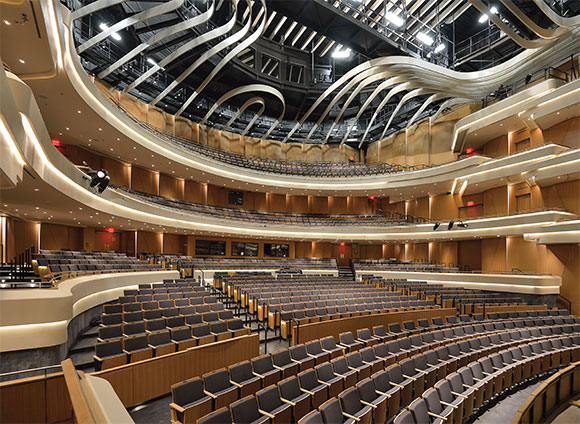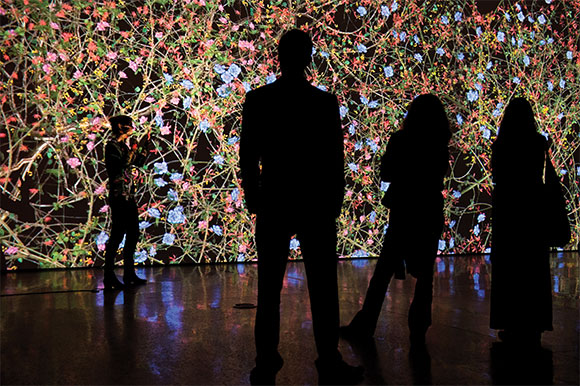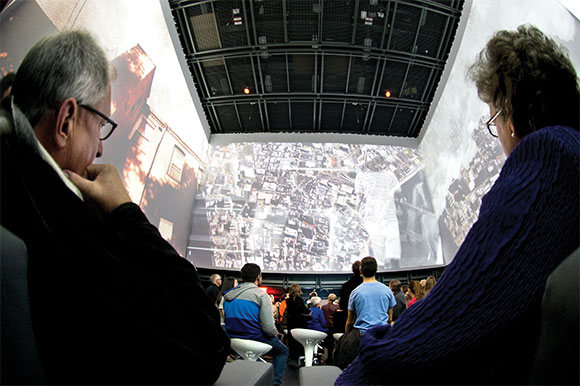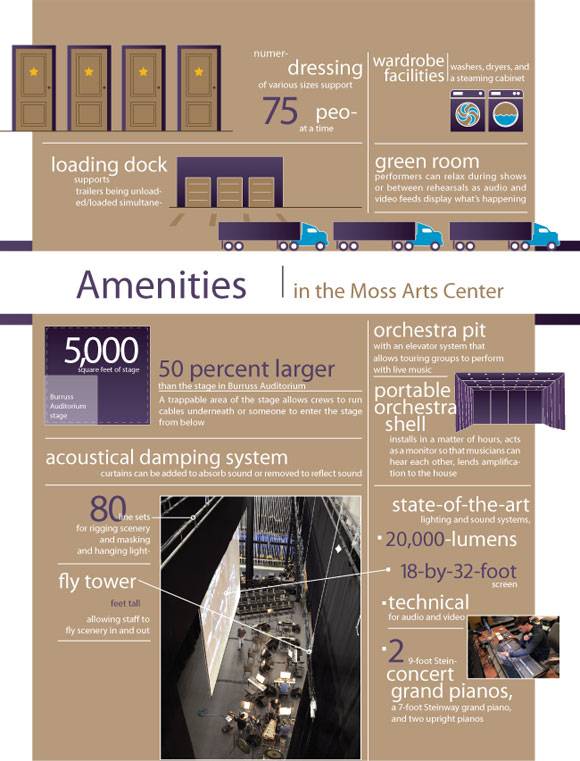FEATURE
The Moss Arts Center glistened in the drizzly night, a beacon for visitors keen to step inside and experience the long-awaited venue. More than a decade in the making, the center had at last sprung to life, its works of art and technology eliciting curiosity and enthusiasm from its patrons.
When the center's galleries opened, community members basked in the vivid hues of digital artist Leo Villareal's work and Jennifer Steinkamp's towering virtual garden. Later that week, the Philip Glass Ensemble presented the center's inaugural performance, an evening that may come to signify a seminal moment in Virginia Tech's history, that instant when the arts assumed their rightful place alongside other pillars of a comprehensive university.
Positioned at the edge of campus and meant to act as a bridge between the university and surrounding community, the Moss Arts Center was designed by internationally renowned architecture firm Snøhetta. The building, named for Virginia artist and philanthropist Patricia Buckley Moss, houses the Center for the Arts at Virginia Tech, a professional presenting program that brings world-class artists and performers to Blacksburg.
The Anne and Ellen Fife Theatre in the Street and Davis Performance Hall manages a rare feat—to be both grand and inviting for those in its 1,260 seats. Every aspect is designed with both acoustics and comfort in mind. "There's just not a bad seat in the house," said Jonathan Boulter (communication '00), associate director of patron services.

The performance hall was designed to provide audiences with an immersion into the performing arts. "It's a pretty intimate theatre. It's built for the audience, and I think it will create such a great experience for our audience—and for multiple events. If it's an orchestra, a spoken-word [event], even a dance troupe, [this space] provides so much versatility," said Boulter, who most recently managed the front-of-house operations and box office for the Cirque du Soleil show at Downtown Disney.
The view from the stage is just as special. The Blacksburg Children's Chorale, directed by Patrice Yearwood (music education '81), performed on stage with the Philip Glass Ensemble during the center's inaugural performance. "As a director of children, my focus was on them, and they were very excited and nervous. I had told them it was a once-in-a-lifetime event, and it was—for all of us. We were so focused on the music and doing a really fantastic job because it was such a large-scale event," Yearwood said. "The stage was empty at dress rehearsal on Wednesday night, so when we walked into the theatre on opening night and saw the lights, the tiers, the box seats, heard the sound—I was struck with the grandness of the place. When … we performed with [the ensemble], it was like magic."
Editor's note: To learn about the performance hall's acoustical excellence, go to "The Sounds of Science."
Imagine that you could stroll through famed scientist Marie Curie's garden, casting your shadow across the daisies, the fuchsia, and the rambler rose. That's the sort of interactive experience that internationally renowned digital artist Jennifer Steinkamp offers in her video installation, "Madame Curie, 2011." The work of art, in which the flowers of Curie's garden are recreated entirely out of computer code and sweep across the wall in a continuous cycle, was displayed in the center's Ruth C. Horton Gallery—the first installation in that space.

Because Steinkamp's work interacts with the architecture of a space, choosing a piece that would fit into the gallery's design was a painstaking process involving nearly a year of discussion. "The best fit for the piece is actually the university itself, being a place where there are many scientists. The piece gets a deeper appreciation in that context. Beyond the architecture is that context of the school," said Steinkamp.
Margo Crutchfield, curator at large for the center, noted that the center's first exhibits were selected to reflect the university's strengths in science and technology. "We are bringing artists of exceptional quality, of national and international renown. They're top-notch artists. But that's not all. We're also going to be showing artists living here and elsewhere in Virginia," said Crutchfield.
Crutchfield said an exciting moment for her was seeing the diverse attendees at the gallery's opening exhibitions in October. "I felt really gratified that the art displayed at the center was reaching as many people as it did—and as it will."
In the Cube in the Moss Arts Center, onlookers gazed up at the images that surrounded them, completely immersed in Joan Grossman's "This Edge I Have to Jump," a digital journey into the creative process. Combining music, sound effects, and abstract imagery with interviews with everyone from a mechanical engineer to a tap dancer, Grossman's video installation examined the countless and often idiosyncratic approaches people take to creativity. On the exhibit's opening night, some visitors sat on sleek white stools, spinning to catch a glimpse of the video on each of the four screens. Others simply stood, caught up in an exhibit that was both psychically and visually enveloping.
Grossman, a visiting assistant professor of cinema in the School of Performing Arts who was commissioned to create the piece, said she wanted "people to feel like they can just relax with the work."
She was also struck by the versatility of the Cube. During the opening week, the space hosted a Halloween-themed, family-friendly event called Tech-or-Treat. "That showed right out of the gate that the space can function in very different ways and that the space can transform really effectively," Grossman said.
Originally designed as a three-story black-box theatre, the Cube quickly evolved into a research space as well, noted Ben Knapp, director of the Institute for Creativity, Arts, and Technology (ICAT), a newly created university-level research institute housed in the Moss Arts Center. The Cube allows researchers to create and physically explore 3-D renderings of large objects like Boeing 767 jets or homes for the elderly, or to perform advanced acoustics research. "When we put approximately 150 speakers in the space, you will be able to focus sound. So, all of a sudden, you will hear something in one area of the cube that you couldn't hear in another area. We will have a realistic acoustic environment as well as a realistic visual environment," said Knapp. "More abstractly, we can begin to look at and listen to data. We can look at a genome. We can hear models of contagion. ... We can look at any kind of data, whether it's engineering, whether it's scientific, whether it's artistic."

Whether the Cube is serving as a performance venue, a high-tech art exhibition space, or a state-of-the-art research facility, "this space is the perfect demonstration of the partnership between the Center for the Arts and ICAT," said Knapp.
"What this facility gives us is the ability to support the vast majority of touring groups of all different genres," said Doug Witney (theatre arts '86), production services director for the center, explaining that dance ensembles, theatre companies, and a range of other touring groups need a certain amount of technology and space. "It's just the right size for Virginia Tech," Witney said. "There are very few places that have the combination of facilities that we have here—the Cube, the performance hall, the TV studio, the outdoor spaces."
For a large touring company of performers and technicians, there's much to worry about when on the road. That's where people like Sara Bailey (theatre and cinema '11), program manager for the center, come in. Beyond her role in creating contracts and handling other arrangements in advance of opening nights, Bailey also makes sure that the backstage area meets the needs of visiting performers once they arrive. That might mean stocking the green room with a shopping cart's worth of goodies—or making sure that one musician had a piano in his dressing room. "Pretty much everyone I take into the green room thinks it's great," said Bailey, who recalled being shown early plans for the building as an undergraduate. "I thought, 'Wow, one day I could work there.' Working here is a dream come true."
click image to enlarge
Produced by University Relations